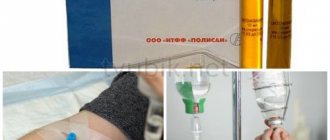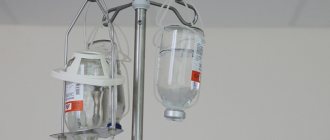Pharmacological properties of the drug Human immunoglobulin
Immunobiological agent, highly purified polyvalent human immunoglobulin. Immunoglobulin contains about 90% monomeric IgG and a small fraction of decomposition products, dimeric and polymeric IgG and IgA, IgM in trace concentrations. The distribution of IgG subclasses in it corresponds to their fractional distribution in human serum. It has a wide range of opsonizing and neutralizing antibodies against bacteria, viruses and other pathogens. In patients with primary or secondary immunodeficiency syndromes, it provides replenishment of missing IgG class antibodies, which reduces the risk of developing infection. In some other immune disorders, such as idiopathic (immune origin) thrombocytopenic purpura and Kawasaki syndrome, the mechanism of clinical effectiveness of immunoglobulin is not entirely clear. After IV infusion, a redistribution of immunoglobulin occurs between the blood plasma and the extravascular space, and equilibrium is achieved after approximately 7 days. Antibodies present in exogenous immunoglobulin have the same pharmacokinetic characteristics as antibodies in endogenous IgG. In individuals with normal serum IgG levels, the biological half-life of immunoglobulin averages 21 days, while in patients with primary hypogammaglobulinemia or agammaglobulinemia, the half-life of total IgG averages 32 days (however, there is significant individual variation that may be important when establishing a dosage regimen for a particular patient).
Indications for use of the drug Human immunoglobulin
Replacement therapy for the prevention of infections in primary immunodeficiency syndrome: agammaglobulinemia, common variable immunodeficiencies caused by agammaglobulinemia or hypogammaglobulinemia, deficiency of IgG subclasses; replacement therapy to prevent infections in secondary immunodeficiency syndrome caused by chronic lymphocytic leukemia, AIDS in children, bone marrow transplantation; idiopathic (immune origin) thrombocytopenic purpura; Kawasaki syndrome (usually as an adjunct to standard treatment with acetylsalicylic acid); severe bacterial infections, including sepsis (in combination with antibiotics), and viral infections; prevention of infections in premature infants with low birth weight (less than 1500 g); Guillain-Barré syndrome and chronic inflammatory demyelinating polyneuropathy; neutropenia of autoimmune origin and autoimmune hemolytic anemia; antibody-mediated true red cell aplasia; thrombocytopenia of immune origin, for example post-infusion purpura or isoimmune thrombocytopenia of newborns; hemophilia caused by the formation of antibodies to factor P; treatment of myasthenia gravis; prevention and treatment of infections during therapy with cytostatics and immunosuppressants; prevention of recurrent miscarriage.
HUMAN IMMUNOGLOBULIN NORMAL
Directions for use and doses
The dose of the drug and the frequency of its administration depend on the indications for use.
Prevention of hepatitis A
The drug is administered once in doses: children from 1 to 6 years old - 0.75 ml, up to 10 years old - 1.5 ml, over 10 years old and adults - 3 ml. Repeated administration of immunoglobulin if necessary to prevent hepatitis A is indicated no earlier than after 2 months.
Preventing measles
The drug is administered once from the age of 3 months to persons who have not had measles and are not vaccinated against the infection, no later than 6 days after contact with the patient. The dose of the drug for children (1.5 or 3 ml) is determined depending on the state of health and the time that has passed since contact. For adults, as well as children, in contact with mixed infections, the drug is administered in a dose of 3 ml.
Prevention and treatment of influenza
The drug is administered once in doses: children under 2 years old - 1.5 ml, from 2 to 7 years old - 3 ml, over 7 years old and adults - 4.5-6 ml. When treating severe forms of influenza, repeated (after 24-48 hours) administration of immunoglobulin in the same dose is indicated.
Prevention of whooping cough
The drug is administered twice with an interval of 24 hours in a single dose of 3 ml to children who have not had whooping cough, at the earliest possible date of contact with the patient.
Prevention of meningococcal infection
The drug is administered in single doses to children aged 6 months to 7 years no later than 7 days after contact with a patient with a generalized form of meningococcal infection in doses of 1.5 ml for children under 3 years of age and 3 ml for children over 3 years of age.
Prevention of polio
The drug is administered once in doses of 3-6 ml to unvaccinated or incompletely vaccinated children with polio vaccine as early as possible after contact with a patient with the paralytic form of polio.
Treatment of hypo- and agammaglobulinemia
The drug is administered at a dose of 1 ml per 1 kg of body weight, the calculated dose can be administered in 2-3 doses with an interval of 24 hours. Subsequent administrations of immunoglobulin are carried out according to indications no earlier than one month later.
Increasing the body's resistance during the period of convalescence of acute infectious diseases with a protracted course and in chronic and protracted pneumonia
The drug is administered in a single dose of 0.15-0.2 ml per 1 kg of body weight. The frequency of administration (up to 4 injections) is determined by the doctor; the intervals between injections are 2-3 days.
Immunoglobulin is injected intramuscularly into the upper outer quadrant of the gluteal muscle or the outer surface of the thigh. The drug should not be administered intravenously.
Before administration, ampoules with the drug are kept for 2 hours at room temperature (18-22) °C.
To avoid foam formation, the drug is drawn into a syringe with a wide bore needle.
The drug cannot be stored in an opened ampoule.
Persons who received the drug should be observed for 30 minutes; in the room where the drug is administered, there must be means of anti-shock therapy. When anaphylactic reactions develop, antihistamines, glucocorticosteroids and adrenergic agonists are used.
Indication of the characteristics of the action of the drug when first taken or when discontinued
The maximum concentration of antibodies in the blood is reached after 24 hours; the half-life of antibodies from the body is 4-5 weeks. A temporary increase in the content of injected antibodies in the patient’s blood after the administration of immunoglobulin can cause false-positive results of serological tests.
Use of the drug Human immunoglobulin
IV drip. The regimen of use is determined individually, taking into account the indications, severity of the disease, the state of the patient’s immune system and individual tolerance. The dosage regimens given below are advisory in nature. For primary immunodeficiency syndromes, a single dose is 200–800 mg/kg (average 400 mg/kg). Administered at intervals of 3–4 weeks to achieve and maintain a minimum level of IgG in the blood plasma of at least 5 g/l. For secondary immunodeficiency syndromes, a single dose is 200–400 mg/kg. Administer at intervals of 3–4 weeks. For the prevention of infections in patients undergoing bone marrow allotransplantation , the recommended dose is 500 mg/kg. It can be administered once 7 days before transplantation and then repeated once a week for the first 3 months after transplantation and once a month for the next 9 months. For idiopathic thrombocytopenic purpura, an initial single dose of 400 mg/kg is prescribed, administered for 5 consecutive days. It is possible to prescribe a total dose of 0.4–1 g/kg once or over 2 consecutive days. If necessary, further doses of 400 mg/kg can be administered at intervals of 1–4 weeks to maintain a sufficient platelet count. For Kawasaki syndrome, 0.6–2 g/kg is administered in several doses over 2–4 days. For bacterial infections (including sepsis) and viral infections, 0.4–1 g/kg is administered daily for 1–4 days. To prevent infection in premature infants with low birth weight, 0.5–1 g/kg is administered at intervals of 1–2 weeks. For Guillain-Barré syndrome and chronic inflammatory demyelinating polyneuropathy, 0.4 g/kg is administered for 5 consecutive days. If necessary, 5-day courses of treatment are repeated at intervals of 4 weeks. Depending on the specific situation, the lyophilized powder can be dissolved in 0.9% sodium chloride solution, water for injection or 5% glucose solution. The concentration of immunoglobulin in any of these solutions can vary from 3 to 12% depending on the volume used. For patients receiving immunoglobulin for the first time, it is recommended to administer it in the form of a 3% solution, and the initial infusion rate should be from 0.5 to 1 ml/min. If there are no side effects during the first 15 minutes, the infusion rate can be gradually increased to 2.5 ml/min. For patients who regularly receive and tolerate immunoglobulin, it can be administered in higher concentrations (up to 12%), but the initial infusion rate should be low. If there are no side effects, the infusion rate can be gradually increased.
Use of the drug during pregnancy
The role of immunoglobulins is especially important in the treatment of diseases in pregnant women. Their body is extremely sensitive to medications, many of them are simply contraindicated. Immunoglobulins are simply irreplaceable in this situation. They are non-toxic and do not harm the body. These are the drugs that increase the level of a person’s defense system and help him independently overcome the disease or prevent its development.
However, studies on the reaction of the body of pregnant women to the action of the drug have not been conducted, so there is no information about how harmful or harmless normal human immunoglobulin is during pregnancy and lactation. During pregnancy, the drug can be used in situations where there is an urgent need for its administration, if the potential benefits to the expectant mother's body outweigh the possible risks to the fetus.
During breastfeeding, normal human immunoglobulin should also be used with extreme caution, as it can enter the baby’s body through breast milk.
Side effects of the drug Human immunoglobulin
more likely during the first infusion; occur soon after the start of the infusion or during the first 30–60 minutes. From the side of the central nervous system: possible headache, nausea; less often - dizziness. From the digestive tract: in rare cases - vomiting, abdominal pain, diarrhea. From the cardiovascular system: rarely - arterial hypotension or hypertension (arterial hypertension), tachycardia, feeling of constriction or chest pain, cyanosis, shortness of breath. Allergic reactions: very rarely, severe arterial hypotension, collapse and loss of consciousness have been observed. Other: possible hyperthermia, chills, increased sweating and fatigue, malaise; rarely - back pain, myalgia; numbness, hot flashes, or cold sensation.
Special instructions for the use of the drug Human immunoglobulin
Immunoglobulin is obtained from the blood plasma of healthy donors who, according to clinical examination, laboratory blood tests, and medical history, do not have signs of transfusion-transmitted infections or blood-derived drugs. In case of severe side effects (severe arterial hypotension, collapse), the infusion should be stopped; IV administration of adrenaline, corticosteroids, antihistamines and plasma expanders may be indicated. Patients with agammaglobulinemia or severe hypogammaglobulinemia who have never received immunoglobulin replacement therapy or have received such therapy more than 8 weeks ago have an increased risk of developing hypersensitivity reactions (including anaphylactic shock) when administered by rapid intravenous infusion. Therefore, rapid infusion is not recommended for these patients and should be closely monitored throughout the infusion period. A transient increase in creatinine levels has been reported after the administration of immunoglobulin to patients with impaired renal function caused by an underlying disease (diabetes mellitus, systemic lupus erythematosus). In such patients, serum creatinine levels should be monitored for 3 days after infusion. After the administration of immunoglobulin, a passive increase in the level of antibodies in the patient’s blood may be observed, which can lead to an erroneous false-positive interpretation of the results of serological testing. Although there are no reports of adverse effects on the fetus or reproductive capacity, immunoglobulin should be used in pregnant women only when clearly needed.
Instructions for use
The active ingredients of normal human immunoglobulin are immunoglobulins, which contain antibodies of various specificities. The preparation contains from 9.5 to 10.5% protein. The maximum concentration of antibodies in the blood is determined 24-48 hours after administration of the drug. The half-life of antibodies is 4-5 weeks.
Normal human immunoglobulin (instructions are in the box) is available in the form of a solution in ampoules of 1.5 ml (1 dose). One package may contain 5, 10 or 20 ampoules of the drug. The kit includes an ampoule nail file. The drug is dispensed in pharmacies with a doctor's prescription. Immunoglobulin in ampoules is transported and stored at air temperatures from +2 to +8°C.
Immunoglobulin is injected intramuscularly into the outer upper quadrant of the buttock or the anterior surface of the thigh. The drug is not administered intravenously. Nurses at the Yusupov Hospital strictly follow the rules of asepsis and antisepsis when performing immunoglobulin injections. Before injection, ampoules with human immunoglobulin are kept for two hours at room temperature.
To prevent foam from forming in the syringe, the drug is drawn into the syringe with a wide-bore needle. It is injected by changing the needle. The drug in an opened ampoule cannot be stored. At the Yusupov Hospital, patients are not administered immunoglobulin if the integrity or labeling of the ampoules is damaged. The drug is unsuitable for use if the solution becomes cloudy, changes color, has flakes that do not break, as well as immunoglobulin that was stored in improper conditions or has expired.
Make an appointment
Drug interactions Human immunoglobulin
Concomitant use of immune globulin may reduce the effectiveness of active immunization against measles, rubella, mumps and varicella. In this regard, live viral vaccines for parenteral use should not be used for 6 weeks to 3 months after the use of immunoglobulin. In case of repeated administration in doses from 400 mg to 1 g/kg in children with idiopathic thrombocytopenic purpura or other pathology, vaccination against epidemic hepatitis should be postponed for 8 months. Immunoglobulin should not be mixed in the same volume with any other medications.
Drug interactions
Human normal immunoglobulin is considered pharmaceutically incompatible with other drugs. A separate dropper or syringe must be used for its administration. The simultaneous use of this drug with active immunization agents (for rubella, measles, chickenpox and mumps) may cause a decrease in the effectiveness of therapy. Live viral vaccines administered parenterally can be used no earlier than one month after the administration of normal human immunoglobulin.
In addition, in order to avoid the development of negative consequences, simultaneous administration of this drug with calcium gluconate to infants should not be allowed.









